- Mastering Homework: 15 Strategies to Tackle Assignments Like a Pro »

Mastering Homework: 15 Strategies to Tackle Assignments Like a Pro
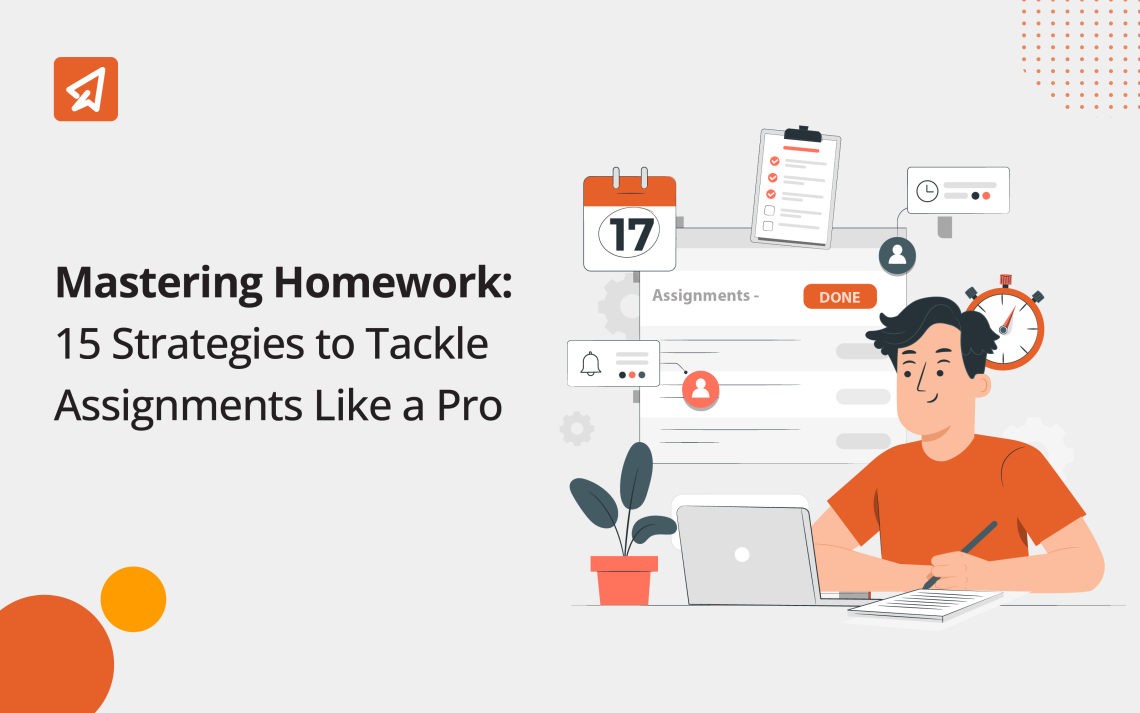
“Homework”. The very phrase can send shivers down the spines of students, evoking images of late nights, overwhelming tasks, and endless frustration. But fear not! We are here to equip you with the ultimate arsenal of strategies for tackling homework that will transform your approach and help you conquer assignments like a true pro. You can use our 15 tried-and-true strategies to tackle homework and learn how to complete tasks efficiently. So, say goodbye to homework blues and get ready to unleash your full potential with these game-changing techniques.
Quick Links
15 Strategies for Tackling Homework
In this section, we will explore 15 powerful strategies that will empower you to take charge of your homework, boost productivity, and achieve academic success.
Tip 1: Set a Dedicated Study Space
Creating a designated study area helps you focus and stay organized. Find a quiet corner where you can concentrate without distractions, ensuring that all necessary materials are within reach.
Tip 2: Plan Your Homework Schedule
Develop a homework schedule that suits your routine. Break your workload into manageable chunks and allocate specific time slots for each task. This approach will prevent procrastination and allow for better time management.

Tip 3: Prioritize Tasks
Start with the most challenging assignments first while your mind is fresh. Prioritizing tasks based on their due dates and complexity will help you tackle them systematically and avoid last-minute stress
Tip 4: Take Regular Breaks
Studying for long stretches without breaks can lead to fatigue and reduced productivity. Incorporate short breaks into your homework sessions to recharge your mind and maintain focus
Tip 5: Use the Pomodoro Technique
The Pomodoro Technique involves working in focused intervals of 25 minutes, followed by a 5-minute break. This structured approach can improve your concentration and efficiency while studying
Tip 6: Avoid Multitasking
Multitasking might seem like a time-saving strategy, but it often leads to decreased productivity. Concentrate on one task at a time, completing it before moving on to the next, to ensure better comprehension and quality work
Tip 7: Seek Clarity
If you encounter difficulties or have questions about a particular assignment, don’t hesitate to seek clarification from your teacher or classmates. Clearing doubts early on will prevent misunderstandings and ensure accurate completion of your homework
Tip 8: Break Down Complex Tasks
Large or complex assignments can be overwhelming. Break them down into smaller, more manageable parts. By dividing the task into smaller goals, you can approach it step-by-step, making it less daunting
Tip 9: Use Productivity Tools
Various productivity apps and tools are available to help you organize your tasks, set reminders, and track your progress. They can help you avoid missing deadlines and complete your homework more efficiently.
Tip 10: Take Proper Notes
Develop effective note-taking strategies during classes to ensure you have organized and comprehensive material to refer back to when doing your homework.
Tip 11: Avoid Procrastination
Procrastination only leads to increased stress and rushed work. Combat this habit by breaking down tasks, setting deadlines, and maintaining a disciplined approach to homework
Tip 12: Take Advantage of Available Resources
Make use of online references, and other learning materials. You should also take advantage of additional features of these platforms to make studying more convenient. Extramarks Smart Class Plus offers after-school connectivity which allows you to access your homework from your phone. Even teachers can check it remotely.
Tip 13: Collaborate With Peers
Teaming up with classmates for group study sessions can be beneficial. Sharing ideas, discussing concepts, and explaining topics to each other can deepen your understanding and make homework more enjoyable
Tip 14: Review and Revise
Before submitting your homework, review your work for errors, clarity, and completeness. Taking the time to revise your assignments ensures that you have produced quality work and avoided unnecessary mistakes
Tip 15: Celebrate Your Achievements
Acknowledge your efforts and celebrate your accomplishments. Rewarding yourself for completing homework tasks will motivate you to maintain a positive attitude toward future assignments
Benefits of Planning Homework

Planning your homework brings a multitude of advantages that can transform your academic experience. Here are a few benefits of using our strategies for tackling homework.
Benefit 1: Improved Time Management
Planning your homework allows you to allocate time efficiently, ensuring you complete assignments on time without feeling overwhelmed
Benefit 2: Reduced Stress Levels
A well-planned homework schedule reduces the stress associated with procrastination and rushed work, enabling you to complete your homework in a timely and efficient manner
Benefit 3: Enhanced Learning
Planning your homework enables you to structure your study sessions effectively. By organizing your workload, you create an environment that promotes focused learning and better retention of information
Benefit 4: Increased Productivity
With a clear plan in place, you can eliminate distractions and optimize your productivity during homework sessions, leading to more efficient completion of tasks
Benefit 5: Better Understanding of Concepts
Planning your homework provides an opportunity to review and consolidate what you have learned in class. This reinforcement aids in better understanding and retention of concepts
Benefit 6: Greater Accountability
A homework plan holds you accountable for completing tasks as scheduled. This sense of responsibility instills discipline and helps you develop essential life skills
Benefit 7: Improved Performance
Effective homework planning allows you to dedicate sufficient time to each assignment, resulting in higher quality work and improved academic performance
Benefit 8: Enhanced Time for Revision
By planning your homework in advance, you can ensure that you have enough time for revision and practice
Benefit 9: Reduced Homework-Related Conflicts
With a structured plan, you can balance your homework with extracurricular activities, family time, and other commitments, minimizing conflicts and creating a harmonious routine
Benefit 10: Increased Confidence
Successfully managing your homework through planning instills a sense of accomplishment and boosts your confidence in your abilities as a student
Planning your homework not only helps you stay organized and manage your time effectively but also offers a range of benefits that contribute to your overall academic success. By employing our strategies for tackling homework, you can experience improved time management, reduced stress levels, enhanced learning, increased productivity, a better understanding of concepts, greater accountability, improved performance, ample time for revision, reduced conflicts, and increased confidence in your abilities.
How Extramarks Smart Class Plus Can Help Students in Planning Homework
Extramarks Smart Class Plus offers a range of connectivity features that make homework planning easier and more efficient.
1. 24×7 Availability of Classroom Lectures
Extramarks Smart Class Plus provides 24×7 access to classroom lectures. Students can catch up on missed lessons or review them to ensure they don’t fall behind in their studies. With the ability to revisit lectures anytime, students can better plan their homework around their learning needs.
2. Supplementary Resources
The platform offers a vast repository of supplementary resources related to in-class lessons. Students can access these resources to enhance their understanding of complex concepts and reinforce their learning. These additional materials provide valuable support in planning and completing homework assignments.
3. One-Tap Video Solutions
Extramarks Smart Class Plus offers comprehensive explanations and visual demonstrations through one-tap video solutions. Students can resolve their doubts and master complex concepts with ease. This feature ensures that students have access to instant guidance, helping them plan and complete their homework efficiently.
Extramarks Smart Class Plus goes beyond traditional homework support by offering connectivity features designed to enhance the homework planning process. By leveraging these features, you can stay organized, access additional learning materials, resolve doubts instantly, and maximize your productivity in planning and completing your homework. Extramarks Smart Class Plus can be your companion on your journey to academic success.
Q1. How can I find the best study space for homework?
Ans: Finding a quiet and comfortable area free from distractions such as a dedicated corner in your room or a library, can be an ideal study space for homework.
Q2. Is it necessary to follow a specific homework schedule?
Ans: Having a homework schedule is highly recommended as it helps you manage your time effectively and ensures that you complete assignments on time.
Q3. How can Extramarks Smart Class Plus help in planning homework?
Ans: Extramarks Smart Class Plus offers after school connectivity which allows students to access their homework from their phone. This allows them to complete it at their own convenience and also allows teachers and parents to know when it has been completed. These features facilitate effective homework planning and help students stay organized and on track.
Q4. Can collaboration with peers improve homework completion?
Ans: Collaborating with peers through group study sessions allows for sharing of ideas, discussion of concepts, and clarification of doubts, which can enhance understanding and make homework more manageable.
Q5. How can I stay motivated while tackling homework?
Ans: Staying motivated can be challenging, but you can reward yourself after completing tasks, study in a group, or break down tasks into smaller goals to maintain motivation and make homework more enjoyable.
Last Updated on September 1, 2023

More Recent Blogs

6 Mistakes to Avoid on Exam Day
Are you ready to set off on the treacherous journey of exam day? Well, before […]

Best Timetable for JEE Preparation
JEE Mains is one of the toughest entrance exams in the country. Lakhs of aspirants […]

How STEM Careers Can Set You Up for...
In today’s rapidly evolving world, the significance of STEM (Science, Technology, Engineering, and Mathematics) careers […]
Leave a Reply Cancel reply
Save my name, email, and website in this browser for the next time I comment.

Found the blog insightful?
Get such ed tech insights delivered weekly to your inbox, for free. Subscribe to our newsletter.
- Teaching App
- Live Classes
- Learning App
- School Solutions
- STAR Program
- NCERT Solutions for Class 12
- NCERT Solutions for Class 11
- Solved Board Paper CBSE
- Solved Board Paper ICSE
- CBSE Class 12
- CBSE Class 11
- CBSE Class 10
- ICSE Class 12
- Sample Paper CBSE
- Exam Weightage CBSE
- CBSE Class 12 Solution
- Terms of Use
How can we help you?
- Join Insider
27 Inspirational Homework Areas and Study Stations
Steal ideas from these amazing home office spaces and watch the good grades roll in this semester.
A dedicated space for homework and studying can improve a child’s focus and productivity. Whether you have a large home or a compact apartment, there numerous ways to design an inspiring homework area.
To help you design your own space, we’ll explore 27 creative and functional study station ideas for a variety of needs and spaces.
1. Adjacent Homework Station
Setting up a homework station adjacent to the kitchen allows for independent work while keeping kids close enough for supervision or assistance when needed. The proximity to the kitchen also provides easy access to snacks, fueling those long study sessions.
A bright and lively space can stimulate creativity and encourage learning. To create an inviting atmosphere, opt for vibrant colors like the cheerful yellow cabinets shown here.
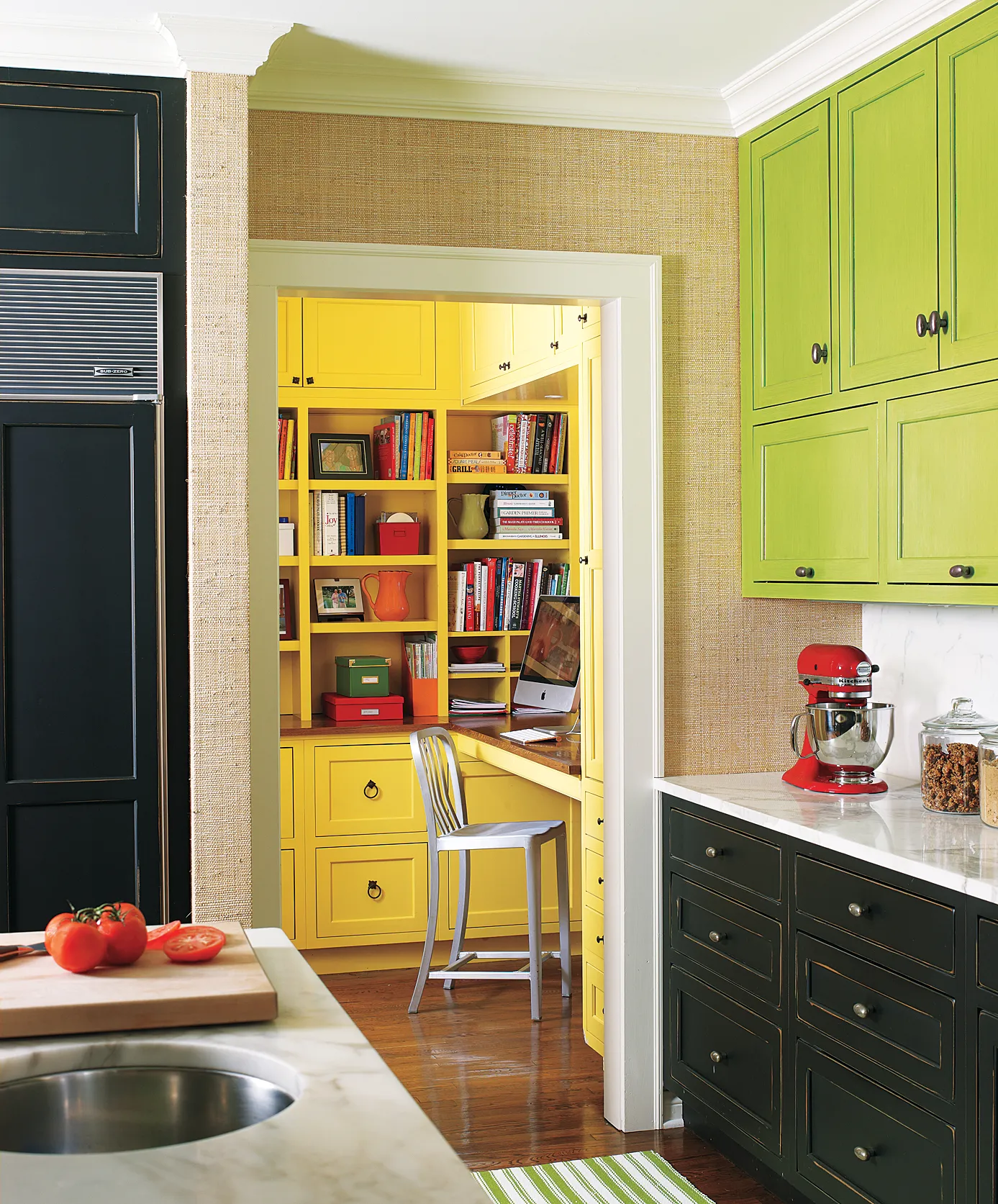
2. Storage-Loaded Homework Alcove
A built-in homework alcove can be great in kids’ rooms. Use stock lumber, storage bins, and sliding tracks to create a compact yet functional workspace. This design not only provides ample storage for school supplies and books but also allows for a retractable work surface, making it ideal for rooms where space is limited.
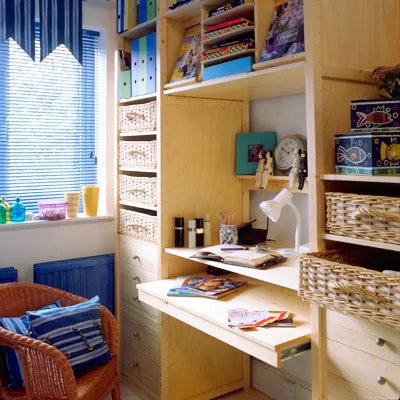
3. Creative Closet Space
Repurposing an underused closet can yield a charming and practical homework nook. Remove the closet doors and line the walls with a fun, eye-catching pattern to transform the space. Involve your child in the design process to make the area appeal to their wants. While their ideas might differ from yours, incorporating their input will make the space more inviting and encourage them to use it regularly for studying. Add personal touches such as their favorite books, a soft rug, or even a small bulletin board for photos and notes.
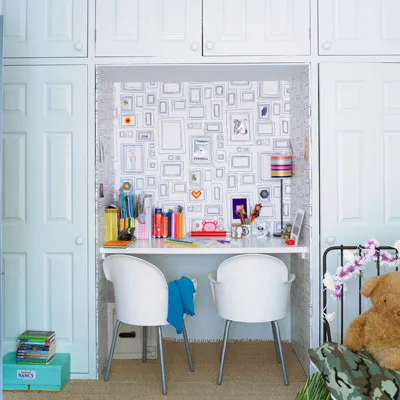
4. Armoire Office
For those seeking a versatile solution, create an armoire office. This clever design features a fold-down table that serves as a workstation when needed and can be tucked away neatly when not in use. The compact nature of an armoire office makes it great for shared spaces or rooms with limited square footage. It also helps maintain a clutter-free environment by concealing study materials when closed. Integrate cable management to keep electronic cords organized and out of sight.
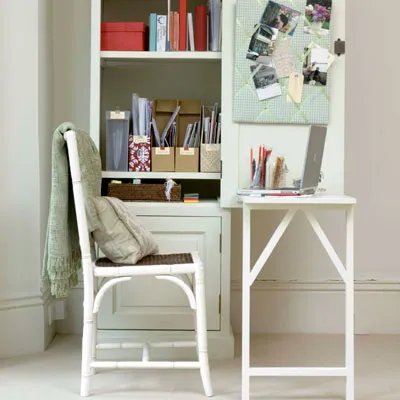
5. Cozy Corner
Sometimes, simplicity is key. A cozy corner study station can be created with minimal effort using wall-mounted shelves or cubbies and a small computer desk. This setup is perfect for children who prefer a more intimate workspace. Personalize the area with inspiring artwork, a comfortable chair, and good lighting to create an atmosphere that encourages focus and productivity. Including a small plant can add some nature, contributing to a calming environment.
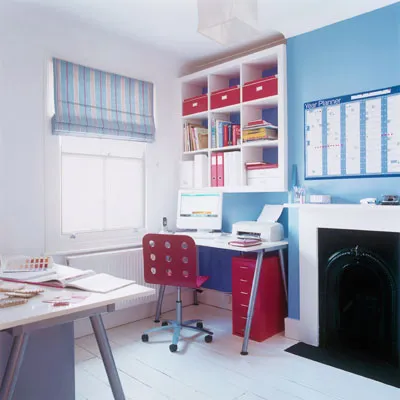
6. Corkboard Wall
Make a bold statement by covering an entire wall with cork tiles or chalkboard paint. This creates a striking visual element while providing a large surface for pinning up schedules, artwork, and reminders. The interactive nature of a corkboard or chalkboard wall can help children stay organized and engaged with their studies. Adding colorful pins and chalk adds a playful element, making the study area more appealing.

7. Kitchen Counter Homework Station
For younger children who require more supervision during homework time, a small desk at the end of a kitchen counter can be ideal. This open-yet-compact workspace allows parents to assist with assignments while preparing meals or attending to other household tasks. The proximity to the kitchen also facilitates easy snack breaks and encourages family interaction during study sessions.
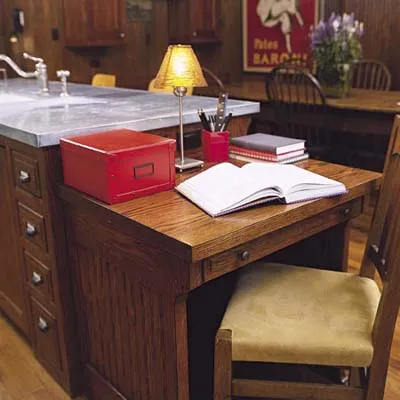

8. Plugged-In Study Nook
In today’s digital age, a well-equipped study area often requires multiple power outlets. Create a plugged-in study nook by carving out space in the kitchen or another central location. Position the desk to face a wall, minimizing distractions and promoting focus. Incorporate built-in cabinetry for ample storage of books, supplies, and electronic devices. This setup makes it so all necessary tools are within reach, streamlining the homework process. Adding a comfortable chair will make long study sessions more manageable and enjoyable.
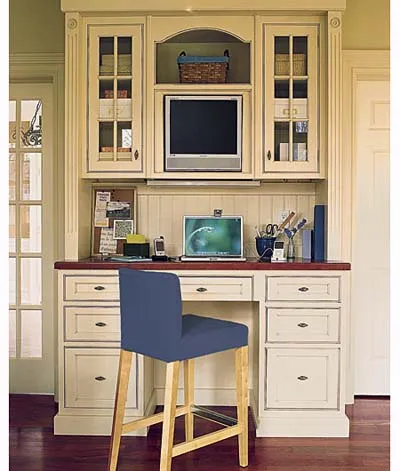
9. Great Room Homework Station
When dedicated office space is limited, integrate a homework station into your great room. Use a vacant wall to create a built-in work unit that complements the room’s overall design. This approach allows for shared use of living spaces while providing a designated area for studying. However, establish rules about television use during homework time to maintain a distraction-free environment. Be sure to add sufficient storage to keep study materials organized and out of sight when not in use.

10. Light, Bright Desktop
Proper lighting reduces eye strain and maintains focus during study sessions. For sit-down kitchen desks or other homework areas, provide adequate illumination by positioning light sources. A good rule of thumb is to leave about 30 inches between the bottom of a pendant light or lampshade and the work surface. This arrangement provides ample light without creating glare or shadows on the desktop. Use LED bulbs for energy efficiency and consistent lighting.
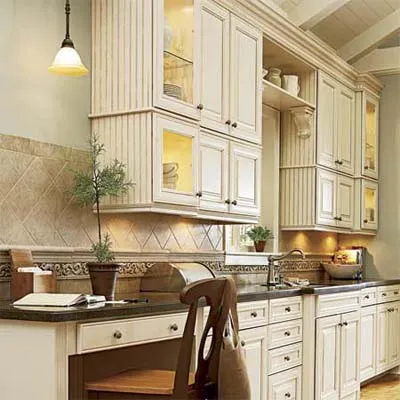
11. Budget Home Office
Creating an inspiring homework area doesn’t have to break the bank. Use leftover materials and bargain finds to design a functional and aesthetically pleasing space. Incorporate a homework nook into existing built-in storage by repurposing shelves or cabinets. This approach not only saves money but also adds character to the space. Use vintage or reclaimed items to create a unique and personalized study area that reflects your child’s interests and personality. Repurposing old furniture and DIY decor can add a personal touch and provide a sense of accomplishment.
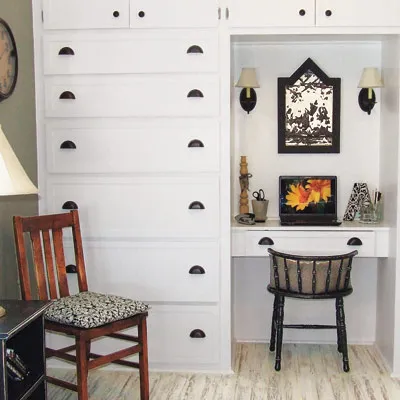
12. Rustic Reclaimed Study Station
For older children or teens, a rustic reclaimed study station can serve as both a functional workspace and a lesson in eco-friendly design. When incorporating salvaged materials, strike a balance between character and simplicity to avoid a cluttered appearance. Use reclaimed wood for desktops or shelving, and repurpose vintage items for storage or decor. This approach not only creates a unique study area but also teaches sustainability and creative reuse. Encourage your child to get involved in the design process to make it a collaborative and educational experience.
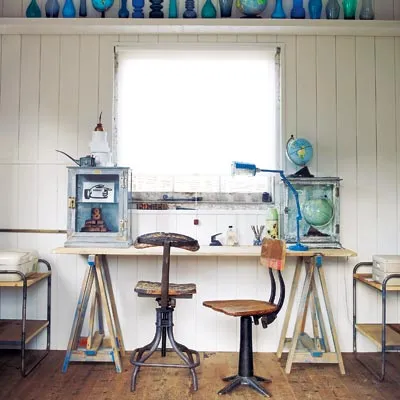
13. Side-by-Side Seating
In households with multiple children or where parents want to work alongside their kids, a side-by-side seating arrangement can be ideal. Include features such as outlets for multiple devices, task lighting, and shared storage. This setup encourages collaborative learning and allows for easy supervision when needed. Using matching chairs and coordinated decor can create a cohesive and harmonious look.
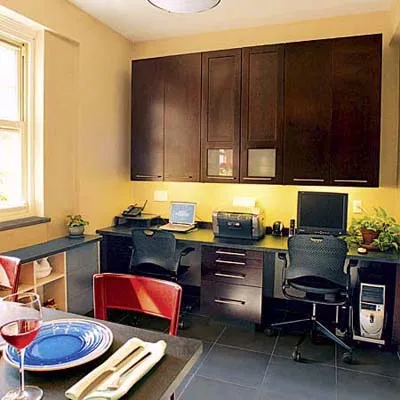
14. Creative Catch-All
A multifunctional homework station can serve as a central hub for various family needs. Incorporate elements such as a first-aid center, tech charging station, and storage for documents alongside the study area. Use a combination of open and closed storage to keep frequently used items accessible while concealing clutter. A corkboard backsplash provides a convenient spot for pinning notes, schedules, and reminders, helping to keep the entire family organized.
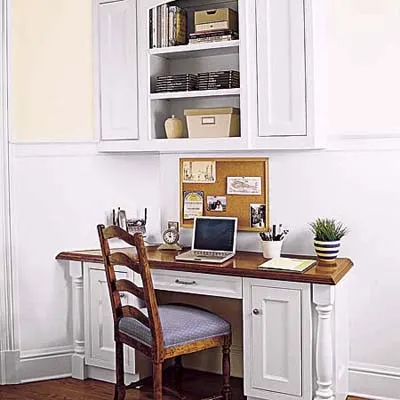
15. Space-Saving Station
For homes with limited floor space, a wall-mounted homework station can be an excellent solution. Design a unit that props up against the wall, similar to a ladder rack, with built-in shelving and a fold-down desk surface. This type of station can be anchored for stability or left portable, allowing for easy relocation if needed. The vertical design maximizes storage while minimizing the footprint, making it perfect for small bedrooms or shared living spaces. Incorporate hooks and pegs for additional hanging storage options.
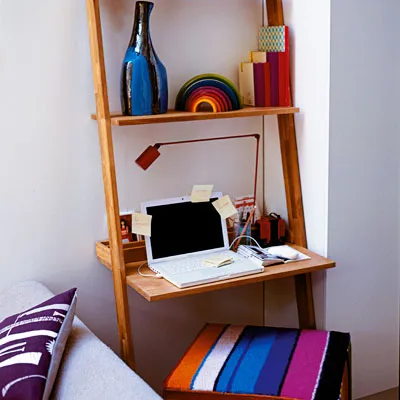
16. Modern Home Office
Create a sleek and modern homework area by incorporating floating storage units and minimalist design elements. Large, high-impact shadowboxes can serve as both decorative features and functional storage spaces. This approach keeps the floor clear, creating a sense of openness and making the room appear larger. Choose a cohesive color scheme and streamlined furniture to complete the contemporary look. Use clear containers to store supplies, maintaining a tidy and uncluttered appearance.

17. High Impact Work Station
Add a pop of color and personality to your child’s study area with boldly colored storage. Use vibrant boxes for organizing supplies and color-coordinated binders for filing completed assignments and papers. This makes the space visually appealing and helps children develop organizational skills by associating different colors with specific subjects or types of materials. Use magnetic containers for small items to keep them easily accessible and neatly organized.
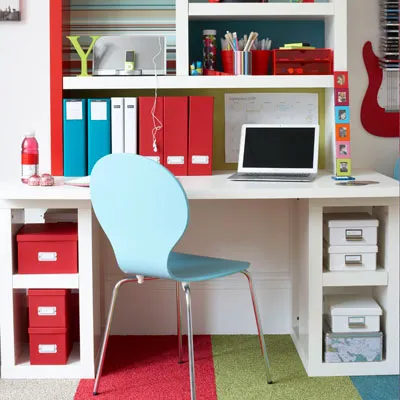
18. Hidden Study Station
In shared living spaces, a hidden study station can help maintain a clutter-free appearance when not in use. Use slim bifold doors to conceal the workspace, allowing it to blend seamlessly with the surrounding decor. This is particularly useful in living rooms, dining areas, or bedrooms where you want to maintain a cohesive aesthetic while still providing a dedicated homework space. Select furniture that matches the room’s existing style to create a harmonious look.
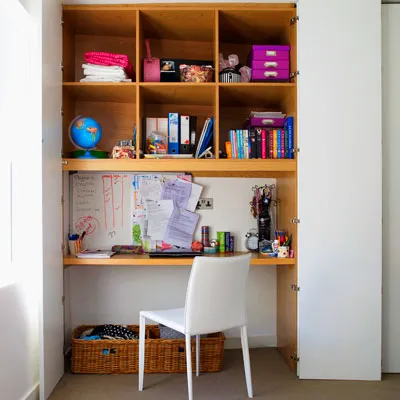
19. Wall-Mounted Wonder
Maximize vertical space with a wall-mounted folding desk that doubles as a covered storage unit. This compact solution is perfect for small rooms or areas where floor space is limited. When closed, the unit serves as a decorative wall feature, and when opened, it provides a functional workspace with built-in storage for supplies. Look for easy-to-install options that can be adjusted as your child grows. Add magnetic boards or pegboards above the desk for additional versatile storage.
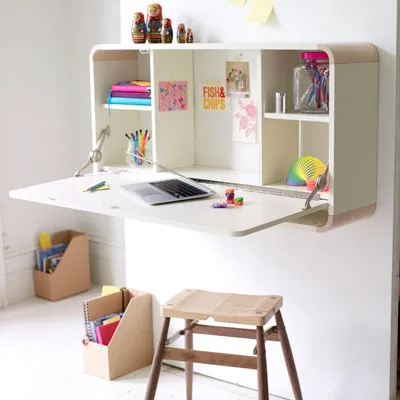
20. Adjustable Storage Station
Create a flexible homework nook using adjustable wall-mounted shelving. This cost-effective alternative to built-in storage allows you to customize the space as your child’s needs change over time. Choose a shelving system that can be easily reconfigured to accommodate different textbooks, supplies, and equipment as your child progresses through school. Integrating various storage solutions such as bins, baskets, and boxes can help keep the area organized and neat.
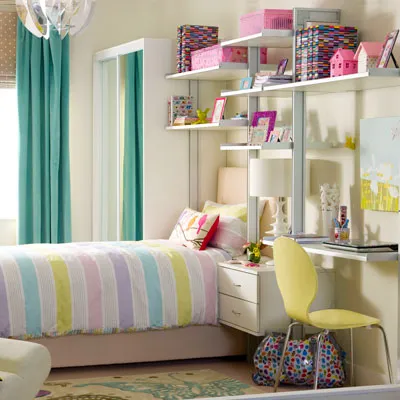
21. Catch-All Cubby Bins
Incorporate open shelving with a variety of storage bins to create a versatile and organized homework station. Choose bins in different materials and colors to add visual interest while maintaining functionality. Wicker baskets can lend a natural, organic feel, while brightly colored fabric bins can inject energy into the space. Label each bin clearly to help your child develop good organizational habits. Use transparent bins for items that are used more frequently, making them easy to locate quickly.

22. Pretty and Punctual Homework Area
Encourage time management skills by incorporating a wall-mounted clock into your child’s study area. Allow your child to personalize the space with a few carefully chosen decor items, striking a balance between functionality and self-expression. This approach helps create a sense of ownership and pride in the workspace, potentially increasing the likelihood of consistent use. Adding motivational quotes or posters can inspire and motivate your child during study sessions.

23. Walled-Off Study Station
In larger rooms, create a dedicated study area using built-in room dividers. This approach provides privacy and helps minimize distractions while maintaining an open feel. Use a combination of open shelving and solid panels to create a semi-enclosed space that can be customized to suit your child’s needs and the room’s overall design. Integrate lighting such as desk lamps or wall-mounted sconces to make sure the area is well-lit.
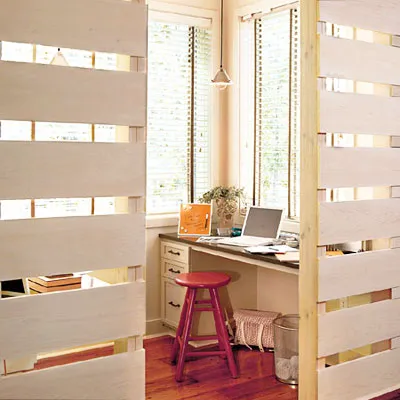
24. Work Space With a View
Position desks near windows to take advantage of natural light and provide a pleasant view during study sessions. This arrangement can help reduce eye strain and create a more inviting atmosphere. Make sure that the view is not overly distracting and use adjustable blinds or curtains to control light levels throughout the day. Add some greenery or decorative plants on the windowsill to create a refreshing and vibrant environment.

25. Kid’s Corner
Transform a small corner of your child’s bedroom into a dedicated homework station. Use corner desks or L-shaped configurations to maximize space efficiency. Add floating shelves above the desk for additional storage and display space. This setup allows your child to have a personal study area without sacrificing too much floor space in their room. Personal touches such as favorite knick-knacks and artwork can make the area more appealing and comforting.
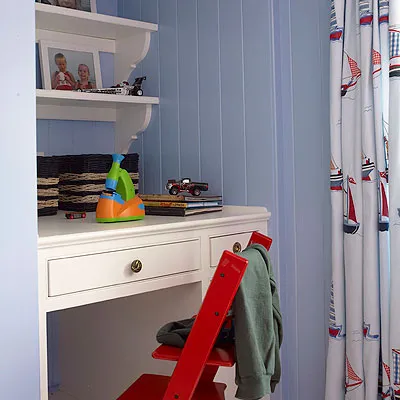
26. In-House Computer Lab
For families with multiple children, creating an in-house computer lab can provide equal access to technology for schoolwork. Make sure that each workstation has sufficient outlets for powering computers and charging devices. Design the space to accommodate different age groups and learning styles, with adjustable seating and desk heights if possible. This shared space can foster a collaborative learning environment while allowing for individual focus when needed. Include noise-canceling headphones to help minimize disturbances when several activities are happening simultaneously.

27. Reader-Created Study Station
Draw inspiration from creative homeowners who have designed unique study spaces for their children. For example, reader Carol Dregne of Galena, Illinois, created a vibrant workstation for her two boys to share. The world map wall covering serves as both an educational tool and an eye-catching backdrop. Incorporate educational elements into your child’s study area to make learning a natural part of the environment. Tailor elements such as world maps, periodic tables, or historical timelines to your child’s interests to make the space more engaging.
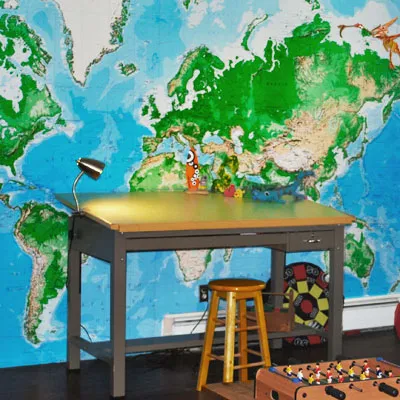
Next Up In Home Offices
- 5 Best Mouse Pads (2024 Guide)
- 5 Best L-Shaped Desks (2024 Guide)
- The 4 Best File Cabinets (2024 Review)
- The 5 Best Office Chairs (2024 Review)
- The 5 Best Fountain Pens (2023 Review)
- The 4 Best Pencil Sharpeners (2024 Review)
Get the latest This Old House news, trusted tips, tricks, and DIY Smarts projects from our experts–straight to your inbox.
How to Help Students Develop the Skills They Need to Complete Homework
Middle and high school students can learn to work more efficiently by using strategies that improve their executive function skills.
Your content has been saved!

The effects of homework are mixed. While adolescents across middle and high school have an array of life situations that can make doing homework easier or harder, it’s well known that homework magnifies inequity . However, we also know that learning how to manage time and work independently outside of the school day is valuable for lifelong learning. From the homework wars to students who have little time for homework to students who don’t even know where to begin, everyone can agree that kids who can self-regulate and engage in independent rehearsal are better positioned for whatever the future holds.
How can we empower students to overcome barriers to doing homework well?
Executive Functioning
Homework is partially an assessment of executive functioning. Executive functioning and self-regulation take time to develop. They depend on three types of critical brain function: working memory, mental flexibility, and self-regulation .
Let’s break this down to consider how to improve their efficiency.
Working memory: Don’t hold everything in your head; it is not possible. When doing homework, students should write down their ideas, whether they are notes while reading, numbers when working through a math problem, or non-school-related reminders about chores, such as remembering to take the dog for a walk. Clearing working memory for the immediate task at hand allows the brain to focus as the strain is reduced.
Mental flexibility: As students build their independence and grow their homework routines, seeing an array of strategies, or more than one way to solve a problem, is important. Consider the results when a child gets stuck and doesn’t know what to do to get unstuck or when one keeps trying the same failed approach. Chunking homework helps simplify the process. When stuck, a student looks at a smaller piece, which makes it easier to see other solutions. More practice with mental flexibility happens when others model thinking in different ways, and students practice flexible thinking with partners by asking them: What is another way? Use this bubble map to chart out multiple ways.
Self-regulation: Learning how to prioritize work and stick with it by not giving in to impulses is a skill that students develop over time . One way to teach self-regulation is to have students practice control by concentrating for short periods of time with the goal of building up to longer, more sustained periods of time as the year progresses. For a child who struggles with reading for an extended time, start with five minutes and then build from there.
Another self-regulation tip is creating a plan to overcome distractions. What happens when the child stumbles? Three minutes into reading and a student is reaching for their cell phone. Recommend that they practice moving the cell phone away from the homework area, and summarize before returning to the reading. Stops and starts are frustrating and often result in lost homework time. Have students practice responses to distraction, and make this part of their homework. When a student struggles to stay on task, they should be encouraged to remove any distraction in order to regain focus.
Use classroom assessment as a tool to plan for and support student homework. Record the following information for students:
- Do they write, read, and/or solve problems in class? For how many minutes independently?
- What is the quality of their work? Are they actually learning, or are they just going through the motions?
- Do they know how to strategize on their own or get help from a peer when they’re stuck? Observe them and take notes, and/or have them reflect on this question.
We cannot expect that students will independently practice a skill they don’t engage with during class. If it doesn't happen in the classroom, it's not going to happen at home. The teacher should be able to realistically gauge how much and what students might achieve at home. A suggestion to build independence is to use task analysis . Here is a model . For students who struggle with getting homework done, at first they may not actually do homework; rather, they practice the routines of setting up and getting started.
Direct Instruction
The following are some techniques that help students with homework:
- Mindful meditation to gain focus
- Prioritizing and estimating time
- Filtering out distractions
Peers as Partners
Class partnership routines need practice. With strong partnerships, kids learn how to support and learn from each other. Access to teachers will never match the unlimited access to peers. The hours that students who achieve at high levels put in after class are often spent alone rehearsing the content or with peers who push each other to improve.
Class-to-Home Connection
While some students struggle with executive functioning, others rush through their homework. The most important step in having homework count is to make it seamless, not separate from class. Homework flows from classwork. Especially with a mix of synchronous and asynchronous work, now there is no homework, just work done for our classes. Consistent instructional goals with engaging and meaningful tasks help students see the value in working beyond the last bell.

NEW Parenting Course: Transform Your Parenting Skills with Holistic Positive Parenting™
How to Create a Homework Space
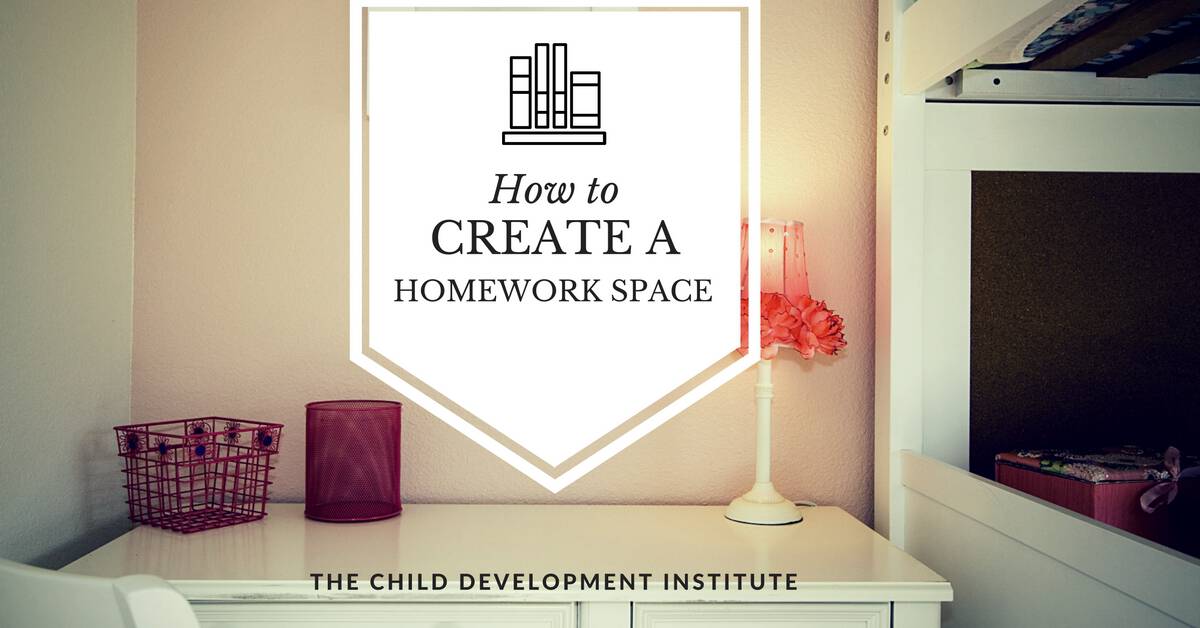
RELATED: Download Our Free Homework Charts !
If your child is like most, doing homework can be a chore. Completing homework is often the last thought on their minds after being in school all day long.
Most children, and teens especially, develop poor homework and study habits, from watching tv to texting while doing homework. The best thing you can do as a parent is set them up early on for success.
Having a workspace designated for homework is a great way to get assignments done quickly and efficiently.
Related: Tips for Helping Kids and Teens with Homework and Study Habits
Pick Your Space
The first step, of course, is to pick your space. It is important to note your child’s learning style. For some, being in the center of the action is the best place for them to do their work. Some children learn better and do homework faster while being in the middle of a little bit of activity .
In contrast, if your child needs lots of quiet and to be away from the center of activity, creating a workspace in the family room or den may not be optimal for that particular child.
You can set up your homework space in a bedroom, den, family room, or even in the basement. Whatever you do, match your child up with his or her learning style and pick the space that is best for him or her.
Make It Fun
Once you have chosen the area for the homework space, make sure to incorporate some fun elements into it as well. If the desk is facing a wall, put up colorful posters or positive images that your child chooses. Studies show that having positive images to look at creates a positive mindset. Examples of this are photographs of nature or beautiful scenery, as well as your child’s favorite movie character or hero.
Incorporate some color into the mix too. Don’t make your child’s workspace bland and boring. Add some vibrant colors to stimulate the mind. Studies also show that certain colors impact the brain in different ways. Some colors are soothing while others are stimulating.
Organize It
After picking the space and colors, make sure you have enough tools on hand for organizational purposes. Being organized is one of the most important keys to successful studying and doing homework.
If you give your child the tools to be organized early on, chances are that it will be a habit they continue with later in life.
Get Their Input
Get your child’s input on the project instead of just doing it yourself. Let your child have some say in where they want their homework space to be, and allow him or her to pick some colors, posters, tools, and materials for their area. In this manner, they will feel more inclined to do their homework and study.
So, there you have it! A few creative ways to get that workspace ready before back-to-school time hits once again.
About The Author

Pamela Myers, BSEd
Child development books.
Our recommendations for books on child development for parents.
The Well Balanced Family
How to disconnect to reconnect so you can grow and have fun together.

We don't sell your information.
The information on this website is solely for informational purposes. IT IS NOT INTENDED TO PROVIDE MEDICAL ADVICE. Neither Parenting Today, LLC nor Dr. Myers nor any of the editors, columnists or authors take responsibility for any possible consequences from any action taken which results from reading or following the information contained in this information. The publication of this information does not constitute the practice of medicine or psychology, and this information does not replace the advice of your physician or mental health care provider. Before undertaking any course of treatment, the reader must seek the advice of their physician or other healthcare provider.
Copyright © 1999-2024 Parenting Today, LLC - All Rights Reserved
Homework challenges and strategies

By Amanda Morin
Expert reviewed by Jim Rein, MA

At a glance
Kids can struggle with homework for lots of reasons.
A common challenge is rushing through assignments.
Once you understand a homework challenge, it’s easier to find solutions.
Most kids struggle with homework from time to time. But kids who learn and think differently may struggle more than others. Understanding the homework challenges your child faces can help you reduce stress and avoid battles.
Here are some common homework challenges and tips to help.
The challenge: Rushing through homework
Kids with learning difficulties may rush because they’re trying to get through what’s hard for them as fast as possible. For kids with ADHD, trouble with focus and working memory may be the cause.
Which of these is your main concern?
- How can I help my child learn to manage emotions?
- My daughter was just diagnosed with dyslexia and I'm not sure what to say to her teacher about it. Any tips?
- Any ideas for how to keep a hyperactive kid busy at home? Are there activities you recommend?
- Ask your own question...
Get answers to all your questions with the Understood Assistant .
Rushing through homework can lead to messy or incorrect homework. It can also lead to kids missing key parts of the assignment. One thing to try is having your child do the easiest assignments first and then move to harder ones.
Get more tips for helping grade-schoolers and middle-schoolers slow down on homework.
The challenge: Taking notes
Note-taking isn’t an easy skill for some kids. They may struggle with the mechanical parts of writing or with organizing ideas on a page. Kids may also find it hard to read text and take notes at the same time.
Using the outline method may help. It divides notes into main ideas, subtopics, and details.
Explore different note-taking strategies .
The challenge: Managing time and staying organized
Some kids struggle with keeping track of time and making a plan for getting all of their work done. That’s especially true of kids who have trouble with executive function.
Try creating a homework schedule and set a specific time and place for your child to get homework done. Use a timer to help your child stay on track and get a better sense of time.
Learn about trouble with planning .
The challenge: Studying effectively
Many kids need to be taught how to study effectively. But some may need concrete strategies.
One thing to try is creating a checklist of all the steps that go into studying. Have your child mark off each one. Lists can help kids monitor their work.
Explore more study strategies for grade-schoolers and teens .
The challenge: Recalling information
Some kids have trouble holding on to information so they can use it later. (This skill is called working memory. ) They may study for hours but remember nothing the next day. But there are different types of memory.
If your child has trouble with verbal memory, try using visual study aids like graphs, maps, or drawings.
Practice “muscle memory” exercises to help kids with working memory.
The challenge: Learning independently
It’s important for kids to learn how to do homework without help. Using a homework contract can help your child set realistic goals. Encourage “thinking out loud.”
Get tips for helping grade-schoolers do schoolwork on their own.
Sometimes, homework challenges don’t go away despite your best efforts. Look for signs that kids may have too much homework . And learn how to talk with teachers about concerns .
Key takeaways
Some kids have a hard time doing schoolwork on their own.
It can help to tailor homework strategies to a child’s specific challenges and strengths.
Sometimes, there’s too much homework for a child to handle. Talk to the teacher.
Explore related topics
- Inspiration
21OAK may earn a commission when you buy through links on our site.
15 Tips for Creating the Most Productive Homework Space
Creating a space in your living area dedicated to homework is a smart move. It creates space dedicated to nothing but homework, and accomplishing your goals. Here’s how to make the most of your space so you can get the best out of time spent doing homework.
The lighting
Keep it neat, put away unnecessary electronics, organize cords, provide ample supplies, print out reference materials, make it inspirational, use a whiteboard, use felt tiles, do your own work together, stick to a schedule, reward hard work.
Choose a room or area that’s in a quiet area. For instance, a desk next to the living room sofa might not be ideal for productivity. Instead, place work areas in vacant rooms or partitioned areas. If you have a large common room you’d like to divide or if you have an open floor plan, consider a room divider like this handmade, woven rattan from Rose Home Fashion that doubles as a shelf.
A productive homework station starts with a designated work space. Promote good posture and concentration with this adjustable from Mount-It!, which also tilts out for more versatile use. The desk starts at 21.3 inches and adjusts up to 30 inches. For older schoolchildren, opt for a desk with enough work space and compartments for desk supplies. Try floating desk for a more modern feel and extra shelf space. It measures 19.8 inches by 42.2 inches by 39.5 inches.
Comfort is crucial, especially for older children (and adults) who need longer working times. An ergonomic swivel chair with an adjustable height is ideal. This from XISHE has an adjustable seat height of 16.5 inches to 20.4 inches. For , consider this chair from VIVO, which has an adjustable seat height of 12.6 inches to 17.3 inches.
A well-lit space is necessary for optimal study performance. Besides installing a ceiling lamp and/or floor lamp, place a reading lamp on each child’s desk. Adjustable that clip onto desks are ideal so you/your child can control the light angle. This LED lamp offers three different color temperatures so your child can choose what helps them work best.
To encourage organization skills, clear your piles, suggests Life Hack . Mesh trays with multiple trays and compartments for smaller supplies like pencils are a popular choice. measures 13 inches in length, 9 inches in width, and 15.5 inches in height. It’s ideal for sorting paperwork for multiple classes. For irregular-sized supplies like arts and crafts material, consider a rolling cart with up to 12 drawers. A large size for this one measures 11 inches wide, 5.5 inches high, and 15 inches deep. For further guidance, take a look at our list of easy desk organization ideas .
If your child does not need a tablet or any other electronics for homework, place the gadget in a designated electronics box. For instance, KWLET’s felt storage box comes in a large size measuring 14.8 inches by 10 inches by 5.1 inches, which is compatible with small tablets and phones. Making your homework station electronic-free removes unnecessary distractions.
If your child does need a tablet or laptop to complete homework, a cord organizer like this rubber one from Toysdone is essential. It keeps cords and cables from tangling and has a weighted base to secure it onto the desk.
Other than the school worksheets or books, children often need additional supplies. A basic supplies sheet includes pencils, pens, glue, colored pencils, markers, crayons, tape, staplers, and erasers. Stay organized with a caddy (7 inches by 14.5 inches by 5.75 inches) or an organizer (8.8 inches by 4.5 inches by 4.15 inches). Other materials include colored paper, graphing paper, lined paper, sticky notes, index paper, and folders.
Supplement school work with other material like this handwriting workbook for young children. Also consider multiplication flash cards to help solidify math lessons. These materials not only help your children study, they also serve as educational activities for when they want to take a break from assignments. For high-school age children, consider subject-specific reference sheets like this Chemistry Quick Study guide by Inc. BarCharts. Other helpful materials include SAT prep books , supplemental math flash cards , and maps.
Bright, motivational posters with encouraging words provide color and help cheer your children on when they feel frustrated with an assignment. Try this six-pack of motivational posters measuring 13.75 inches by 19.75 inches — great for lining up on a single wall or spaced out throughout the room.
A simple dry-erase whiteboard like this foldable double-sided one from Yaze Magnet (16 inches by 12 inches) is ideal for engaged visual learning. Guide your child through simple math problems or the alphabet using a dry-erase board or utilize it for spelling out homework reminders. You may also use a wall calendar.
If you want to skip the traditional square corkboard, try these hexagon felt tiles. One pack includes six pieces measuring 5.9 by 7 by 0.6 inches each. They come in various multicolor packs like blue, red, and white, gray and turquoise, turquoise orange and pink, light gray, and dark gray. The unusual shapes can make your study room feel more fun while keeping small notes, homework pages, and reminders visible.
If possible, stay in the room or nearby to provide support. Try to do your own homework whether it be reading an ebook, organizing digital files, or bullet journaling. Making yourself available to help might make children feel more comfortable and boosts household morale.
Allocate a regular block of time for homework. This can be 4 to 6 o’clock in the afternoon with a five-minute break or 6 to 8 o’clock in the evening for older children. The schedule depends on your family’s overall daily routine. It’s also helpful to carve out time during the weekend to complete longer assignments or projects. When you and your child are used to working at a specific time, this helps promote a responsible work ethic and effective time management. Of course, life happens and sometimes we can’t stick to our original plans, but flexibility and adaptability are just as important to develop.
Build good study habits (and better relationships) by acknowledging hard work. You can provide incentives to complete homework from something simple like daily stickers to extra-meaningful rewards like a day trip to the museum.
Editors’ Recommendations
- How to maximize closet space: Our 10 best tips and tricks
- The best window treatment ideas for every budget and space
- The best greige paint colors that will completely refresh your home
- An entryway mirror can enhance your space: When you should (and absolutely shouldn’t) have one
- Maximize your tiny apartment: Creative Christmas tree solutions for small spaces
- Decluttering
- Home Office
- Remodelling
- Small Spaces

Neutral colors like gray and taupe are always popular options for your home's interior design. Both are versatile shades that can go with a plethora of other hues, which means you can easily change up the look of your decor with gray walls and a rotating rainbow of accessories like colorful throw pillows. With all the different shades of gray paint available, from matte to glossy, warm to cool, and brownish to blueish, it's certainly possible to find the one that's perfect for you and your home.
Of course, you can always have too much of a good thing. While gray can be a sophisticated and elegant shade, too much gray can wash out a room or make it feel dull and dingy or cold and unwelcoming. Think of gray as the neutral backdrop on a canvas that lets your color palette shine, and you can't go wrong. So, it’s important to incorporate other colors into the decor, whether it be with pieces of furniture, art, or throw blankets -- but what colors go with gray? If you're looking for the best options to brighten up your current decor, keep reading to find out how to accent this elegant tone.
Many contemporary homes have open-concept living, meaning fewer walls and shared space between rooms. It's a great idea for those who entertain or want minimal disruption between spaces. It's also good when you have small children and want to keep an eye on them while you're cooking, folding laundry, or watching TV. If you have one large area for your living room and dining room, there are some things you can do to get the most out of each room.
Of course, there's a lot to consider when it comes to which colors to choose, how to arrange furniture in a living room/dining room combo, and what wall and other decor can be used to blend the spaces together. Here's how to find the right mix that works in one collective space.
The basement is a great spot for a designated laundry room due to its open layout and utility hookups. Often, though, the aesthetics leave a lot to be desired.
Your basement laundry room doesn’t have to be dingy or dull; you can make your space more functional and stylish with a few simple changes. Your newly renovated space may even make you enjoy doing your laundry! Here are eight of our favorite basement laundry room ideas and a few considerations to keep in mind while remodeling.

IMAGES
VIDEO
COMMENTS
The document provides a homework assignment to fill in the blanks of sentences with the correct verb form, either past simple or present perfect. It then provides the answers.
You can use our 15 tried-and-true strategies to tackle homework and learn how to complete tasks efficiently. So, say goodbye to homework blues and get ready to unleash your full potential with these game-changing techniques.
Homework busters are thoughts that delay you in starting and completing your homework. Here are some examples. . .
Whether you have a large home or a compact apartment, there numerous ways to design an inspiring homework area. To help you design your own space, we’ll explore 27 creative and functional study station ideas for a variety of needs and spaces. 1. Adjacent Homework Station.
How to Help Students Develop the Skills They Need to Complete Homework Middle and high school students can learn to work more efficiently by using strategies that improve their executive function skills.
Having a space that presents few distractions, contains enough space and light to work comfortably, and provides the tools for the task are all important when choosing a space for homework completion.
Get personalized homework help for free — for real. Brainly is the knowledge-sharing community where hundreds of millions of students and experts put their heads together to crack their toughest homework questions.
Get ready for the school year by creating a designated homework space. Read this article for tips on how to design the perfect space for your child.
Kids with learning differences and ADHD can have homework challenges that other kids don’t. Learn about common homework and studying struggles. And get tips to help with each challenge.
Creating a space in your living area dedicated to homework is a smart move. It creates space dedicated to nothing but homework, and accomplishing your goals. Here’s how to make the most of your space so you can get the best out of time spent doing homework.